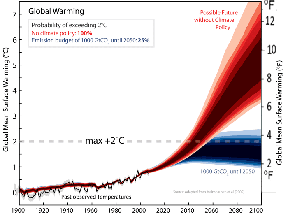His reluctance is understandable; here, roughly, is the comment:

In case anyone wants to know what it is that Russ is showing graphs of here
(Russ, if you're trying to educate your readers rather than snow them, explaining what's being measured will help)
The upper, original graph - with the red dots marking El Nino events - is of Spencer and Christy's ("UAH") dataset for Middle Troposphere("MT") atmospheric temperature over time. (Of 3 research groups using different analyses to measure the middle troposphere, the trend S&C get is the smallest, although still showing warming over time.)
What you should know about this graph of the UAH data:
1. The presentation is misleading - it's designed to emphasize "noise" rather than "signal". It obscures the upward trend in temperature by stretching out the X (time) axis relative to the Y (temp.) axis, and by failing to provide a best-fit (regression?) line to show the trend, which is a warming trend.
2. The dataset itself has a bias. The UAH Middle Troposphere measurements (and trend) are 'contaminated' by contributions from the stratosphere, which is (known and expected to be; ozone depletion plays a role) cooling. Thus the MT actual warming trend is likely steeper than this dataset shows.
(from here: "The University of Washington (UW) versions of the UAH and RSS analyses attempt to remove the stratospheric influence from the mid-troposphere measurements, and as a result the UW versions tend to have a larger warming trend than either the UAH or RSS versions.")

Next graphs:
The four lower graphs are of:
TLT = Temperature of Lower Troposphere (closer to ground)
TMT = Temperature of Middle Troposphere (higher up)
TTS = Temperature of Troposphere / Stratosphere (still higher up)
TLS = Temperature of Lower Stratosphere (still higher up)
Note that the trend for the TLT and the TMT is upward (showing warming), despite Russ's creativity with the red pen on the TLT (temperature of lower troposphere) chart. I think that's against the rules, Russ; it's certainly unusual, and inconsistent with how the other data in same graph are treated.
As mentioned above, the stratosphere (layer furthest from the earth) is cooling, and not germane to global warming, so the TTS and TLS graphs don't tell us anything relevant.
In his use of the first (red-dots") chart, Russ
a) doesn't tell you what his graph is of;
b) fails to mention in text or show on the graph that in fact the data do show a warming trend;
c) has cherry picked the mid-troposphere data (choosing to show mid-troposphere rather than the more accurate (and more warming) lower troposphere data, and further, choosing to show the UAH data, not the RSS or the UW versions which show stronger warming)
Russ, it looks like you're trying to pull the wool over your readers' eyes.
(The upper, "red dots" graph is also addressed here at Skeptical Science.)
Readers, please, wake up - our house is burning.





